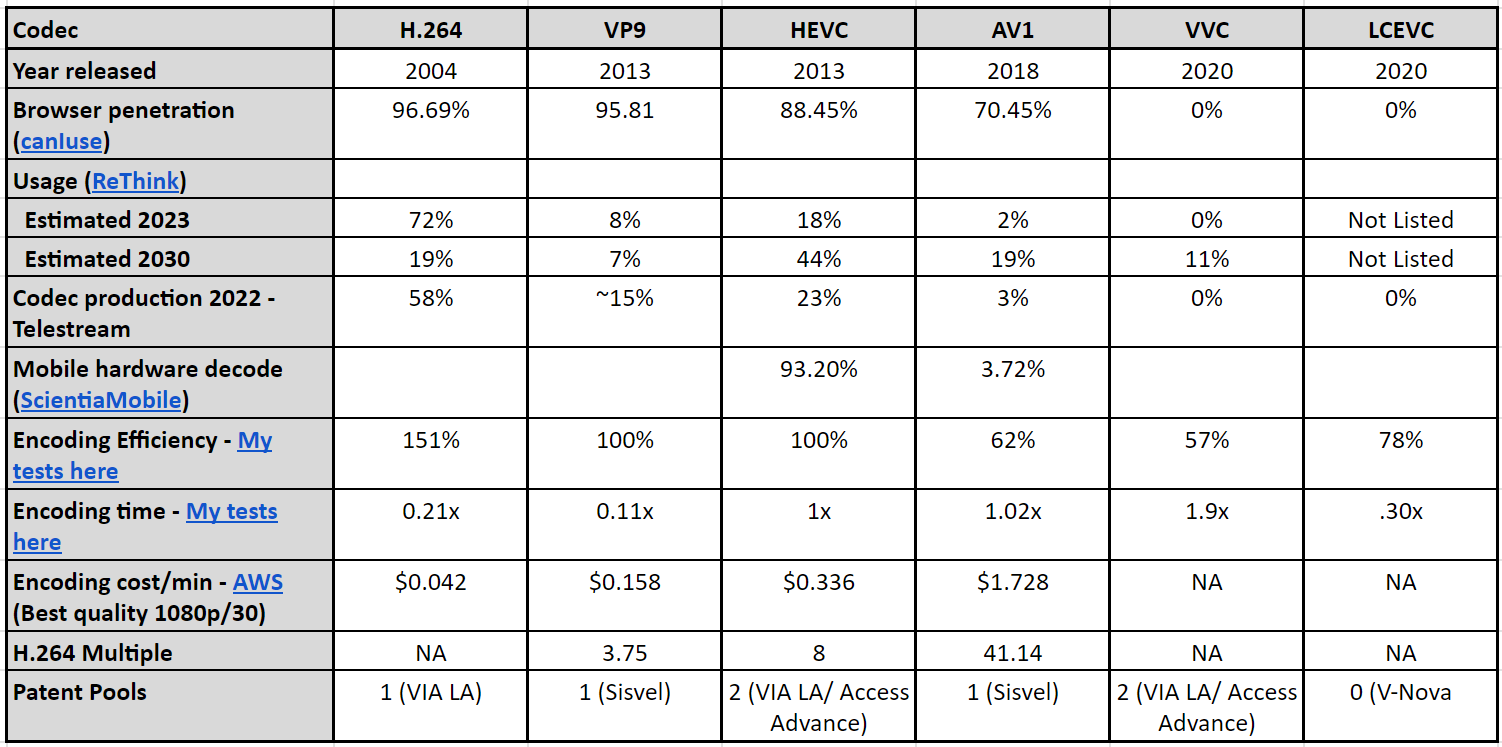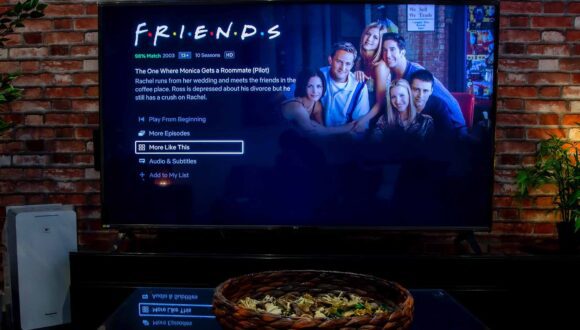This article provides a quick reference for video codec details from H.264 to LCEVC, excluding EVC, because so little progress has been made on productization.
Contents
Codec Overview
Starting at the top, the year released emphasizes how long H.264 has remained the dominant codec, as evidenced by ReThink’s 2023 usage rate of about 72%. Browser penetration, as measured by CanIuse, is the obvious reason why; H.264 simply plays everywhere, though by 2030, ReThink predicts usage will shrink to about 19%
Both VP9 and HEVC launched in June 2013; while VP9 leads in browser penetration, HEVC leads in usage. Looking ahead, ReThink shows VP9 regressing slightly over the next seven years, HEVC is the big winner, jumping 26% from 18% to 44%.
AV1 launched in 2018 and enjoys 70.45% browser support, with the biggest missing chunk attributed to Apple. ReThink’s estimated AV1 usage of 2% is a bit of a head-scratcher, given YouTube’s extensive use of AV1, as well as Meta and Netflix. Of course, Google, Meta, and Netflix are all in the Alliance for Open Media (AOMedia), the organization that created AV1, so their AV1 usage isn’t a surprise.
Many publishers targeting mobile users may look at ScientiaMobile’s hardware support numbers and decide to use HEVC. For the record, ScientiaMobile focused on AV1 and HEVC in their report; I assume that H.264 encode/decode is near universal and that VP9 decode is close. Though not important for this post, which is primarily decode-focused, much of the HEVC mobile support is encode/decode, while virtually all AV1 support is decode only. Between HEVC’s extensive mobile support and HEVC’s near universal share of living room HDR delivery, ReThink’s 2023 estimated usage for HEVC seems very credible.
VVC and LCEVC both launched in 2020. VVC is a traditional MPEG codec that requires hardware support for encode and decode, and it will likely progress slowly but surely (see here). In contrast, LCEVC is an enhancement codec that can run on existing hardware, and it has a chance for a much quicker impact.
Note that ReThink didn’t assign any share to LCEVC in 2030 because it’s an enhancement codec that always uses another codec as a base, which could lead to double counting or other math-related confusion. In terms of LCEVC utilization, the report predicts an attach rate of close to 40% by 2030, or that LCEVC decode will be available on 40% of all playback devices, including computers, mobile, and living room devices. So, ReThink believes that LCEVC’s future is bright.
One late entry into the table is data from Telestream’s Global Media Format Report, resurrected after Telestream’s acquisition of encoding.com. This is the 2023 version which reports on 2022 encoding by encoding.com and Telestream’s cloud encoding facility.
Telestream has multiple OTT publishers as clients, so it’s not surprising that HEVC usage is so high. At ~15%, VPP9 usage was unexpectedly high, though at 3%, AV1 sounds about right for 2022. I’ve heard from multiple publishers that they will be deploying AV1 in 2023 or 2023, so I expect AV1’s percentage to increase quite nicely. If you’re checking my math, Telestream also reported encoding to VP8 format, which didn’t rate a column below, and accounts for the missing 1%.

Encoding Efficiency
The codec efficiency numbers peg HEVC and VP9 at 100 efficiency%. At 151%, you’d have to boost H.264’s bitrate by 51% to achieve the same quality, which obviously directly impacts your bandwidth costs. My tests published here show AV1 about 38% more efficient than HEVC, meaning the same quality at 62% of the bitrate, with an early version of VVC about 43% more efficient. LCEVC using HEVC as a base layer proved 22% more efficient than HEVC.
Encoding times also peg HEVC at 1X and detail how much faster or slower it takes to encode the other codecs (computer details are in the referenced article). So, H.264 is roughly 5X faster, VP9 10X faster, AV1 about the same, VVC about 2X slower, and LCEVC about 3X faster, one of the key benefits of this enhancement codec.
The final two lines show encoding costs for AWS MediaConvert and the cost multiple over H.264. So, VP9 is 3.75X H.264, despite encoding in half the time in our tests. HEVC costs 8X H.264, while only taking 5X the encoding time. AV1 appears out of whack; my tests show the encoding time almost identical to HEVC, yet MediaConvert’s encoding costs are 5X HEVC. I performed my tests with libaom-AV1, not SVT-AV1, and the latter is much faster on the encoding side. Of course, AWS typically creates and deploys its own codecs, so it may actually take eight times longer than HEVC to encode.
Royalty Status
The bottom line shows the royalty status of all the codecs. H.264 shows a single pool, once owned by MPEG LA, now owned by VIA LA, with royalty details here.
Though Google claims that VP9 is open source, Sisvel formed a VP9 pool in 2019; license terms are here.
HEVC has two pools, one by VIA LA (details here), the other Access Advance (license terms here).
Though AOMedia claims that AV1 is open source, Sisvel also formed an AV1 pool in 2019; licence terms are here. Sisvel doesn’t identify licensees but as of August 13, 2023, states that 52 companies are “current VP9/AV1 Licensees.”
VVC also has two pools, also by VIA LA and Access Advance. Note that if you deploy both HEVC and VVC and license both from Access Advance, you can sign a Multi-codec Bridging Agreement (MCBA).
Finally, LCEVC doesn’t have a patent pool; you license the technology through V-Nova. Interestingly, unlike all the other royalties, which are paid mostly by device makers (TVs, mobile phones, tablets, dongles), the LCEVC royalty is paid by the publisher.
 Streaming Learning Center Where Streaming Professionals Learn to Excel
Streaming Learning Center Where Streaming Professionals Learn to Excel









